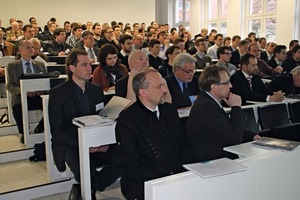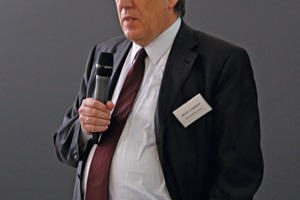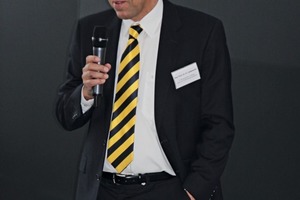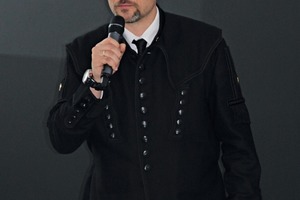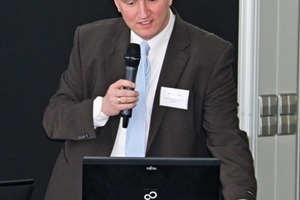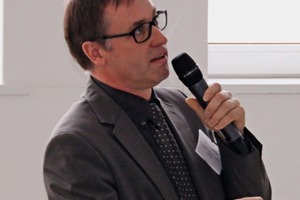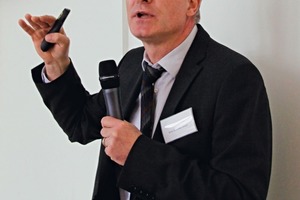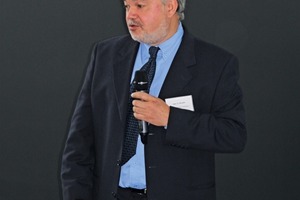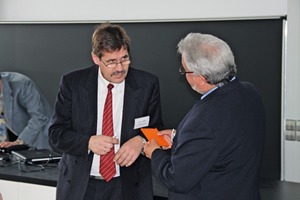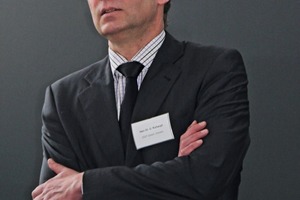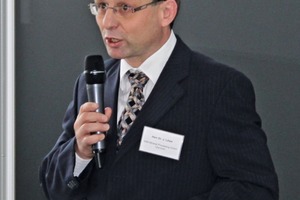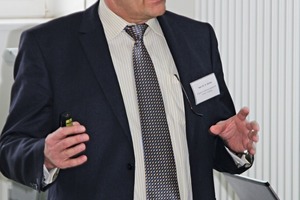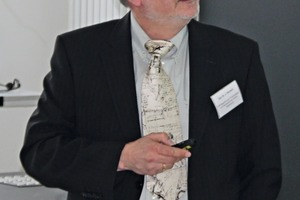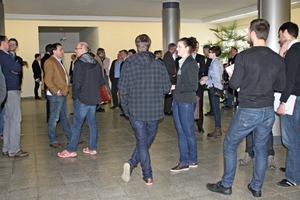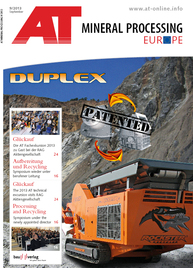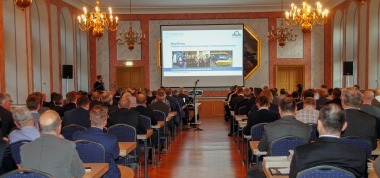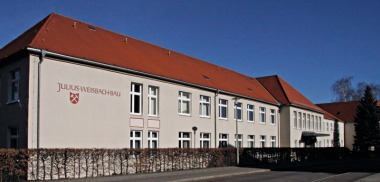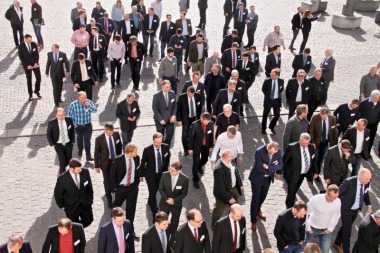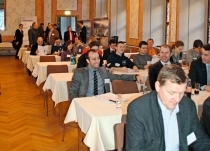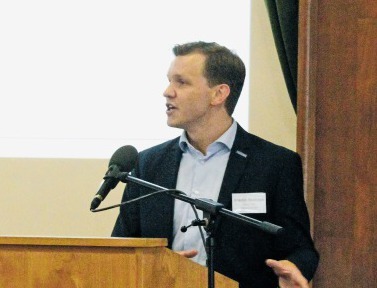Symposium under the newly appointed director
The Institute of Mineral Processing Machines (IAM) at Freiberg University of Mining and Technology worked together with its Friends and Supporters to organize the annual Symposium on Mineral Processing from 7 to 8 March 2013 in its now well-established format. As in previous years, more than 100 representatives from research and industry took up the invitation and attended the event (Fig. 1). They came to find out about current trends, applications and the latest research findings as well as to exchange ideas and information, but also to greet Prof. Dr.-Ing. Holger Lieberwirth as the newly appointed Director of the Institute following a provisional period of five years.
Following a brief introduction of Prof. Dr.-Ing Lieberwirth by Dr Christoph Kemmann (Fig. 2), Chairman of the Friends and Supporters of the Institute of Mineral Processing Machines, the new Institute Director (Fig. 3) detailed the current student numbers for the mechanical engineering course. While there has been a slight decline in these numbers, enrolments in the specialized areas of mineral processing machines as well as mining and civil engineering machines are still enjoying some growth. The Institute offers students an additional certificate with the qualification of graduate engineer for mineral processing and plant engineering, which was developed together with the Friends and Supporters of the IAM and stands for the good cooperation between the university and industry. The additional course programme has been well accepted by the students, especially as it is tailored to the needs of the industry. With the wide range of aspects covered, it offers an attractive field of research with field-oriented assignments, concerning, for instance, crushers/mills, conveyors, wear, maintenance, recycling of plastics, etc. The knowledge acquired and the contacts made in this course can certainly pave the way for an interesting career after graduation.
Dr Kemmann and Prof. Dr Lieberwirth thanked both Dr Thomas Folgner and Dr Meltke, under whose dedicated and competent direction the Institute had been excellently managed and brought forward during the interim period. Not least, on the basis of cooperation with the Friends and Supporters along with the outstanding equipment at the test centre, Prof. Dr Lieberwirth sees an excellent starting point for application-oriented research work in a wide range of subjects relevant to mineral processing. In a later talk, Prof. Dr Lieberwirth explained where the Institute’s research focus will lie in future.
First, however, Prof. Dr. Bernhard Cramer (Fig. 4), Chief Mining Officer in the German state of Saxony, provided an animated overview of active mining in his talk on “Mining in Saxony”. He explained that the extraction of lignite as low-cost fuel is becoming increasingly important again. On the other hand, after ore mining came to end in Saxony in 1991, there has been a revival in the exploration of ore and spar deposits since 2006. Saxony with its wealth of resources also has deposits of copper slate and rare earths and is now attracting international attention from mining companies and investors. And not least thanks to the further developed and refined processes in mineral processing, it is now possible to efficiently exploit previously less profitable deposits. Besides 19 approvals for exploration across Saxony, three mining licences have been issued, and with the Niederschlag fluorspar pit the first “new” spar mine has now gone into operation. After Saxony’s Mining Office approved mining for fluorspar and baryte in 2008, the general plan of operations could be approved in 2011 and a multipurpose building was inaugurated. An underground processing plant is currently being set up and the first fluorspar concentrate is set to be produced by the end of 2013. Thanks to intensive public relations work, the project has met with good acceptance in the local population. The mining activities also enjoy broad political support – in August 2012 the Free State of Saxony approved its resources strategy for Saxony, and in January 2013 the Federal German government launched a programme to support exploration work that can also be used for exploration projects within Germany.
The Niederschlag fluorspar pit is being developed by the Erzgebirgische Fluss- und Schwerspatwerke GmbH (EFS). The plenary lecture by Prof. Dr Cramer was followed by the talk headed “Underground processing plant for fluorspar” by Andreas Kimmeyer (Fig. 5) and Michael Henkel (Fig. 6) from HAVER NIAGARA GmbH, the company contracted by EFS to design the plant. They explained the shaft with the plant set-up and the different technology and processing stages in 3D, with reference to the particular challenges faced in the design, engineering and installation of the plant. Primary crushing and separation of tailings are performed underground and therefore in a confined space, which makes maintenance of the equipment very difficult. As a result, however, transport costs to the wet processing plant (with grinding, flotation and dewatering) 40 km away are reduced, improving cost efficiency. In addition, the coarse tailings remain in the pit for use as backfill.
The next two talks centred on sand processing. Dipl.-Ing. Dietmar Guldan (Fig. 7) from BHS-Sonthofen GmbH reported on the “Production of dry mortar sand”. With the BHS impact mill and impact crusher, the BHS rotor centrifugal crusher and the BHS rotor impact mill, the company has developed special comminution technology capable of processing soft, medium-hard to hard and wear-intensive materials and rocks. Guldan explained the set-up, operating principle and possible applications for the machines based on the example of different grading curves and impressed the attendees with high-speed images documenting the comminution of specific materials fed to the different crushers. Depending on the application, clearly defined grading curves can be obtained, to produce the dry mortar recipes specified by the construction industry. At its test centre, the company has three variants for the production of dry mortar sands. On the basis of these, it can devise a customer-specific design for a dry mortar plant or efficiently adjust and optimize dry mortar recipes to requirements.
The paper on fine screening presented by Dipl.-Ing. Uwe Bruder (Fig. 8), Bruder Consult, discussed “New aspects in dry screening based on the example of the Nobitz screening plant”, which belongs to Heim Industrial Minerals GmbH. The company has set up an innovative sand processing plant in which the utilization of renewable energy (photovoltaic system for the capture of solar power and waste heat from a biogas plant for drying) in combination with sophisticated plant engineering (seven Derrick screens – standard along with the latest dry Stack Sizer – arranged on top of each other and fed by means of only one pocket conveyor) and state-of-the-art screening technology (e.g. newly developed Derrick-PU screening surfaces (Fig. 9), that don’t blind during dry screening) yield outstanding results. The screen in Nobitz features permanent electronic monitoring, easy accessibility and controllability of the screening technology also during ongoing operation, short set-up times, low power consumption, low noise nuisance and low dynamic loads, Moreover, with this highly flexible plant, the product grade can be adapted to customer requirements at any time.
The “Drying of minerals in vibrating fluidized bed” was addressed in the talk given by Dr Ulrich Kohaupt (Fig. 10), Jöst GmbH. Efficiency-improving measures in the further development of dryer technology usually lead to a lower energy requirement combined with optimized product quality. With reference to the example of drying coal flotation concentrate, Kohaupt described the particular challenges, criteria and technical solutions associated with the use of vibrating fluidized bed dryers from Jöst, which feature a particularly low-energy and uniform air flow through the product.
In his paper on the “Design, engineering and operation of crushers and screens with special consideration of dust and noise emissions”, Dr Jens Löwe (Fig. 11), SBM Mineral Processing GmbH, showed how the dust and noise nuisance generated by the use of crushers and screens in the non-metallic minerals industry can be influenced in advance by simple means. He referenced various examples. Already in the project design phase, the decision is taken based on the type of rock, the required size reduction ratio and other quality parameters for the finished product, whether pressure comminution (low dust nuisance, but high noise level) or impact comminution (relatively quiet, but with a high dust nuisance) should be considered. To find the optimum solution approach, various possibilities exist to improve stationary and mobile plants, e.g. with the use of so-called gravel ladders or diesel electric drive concepts, so as to minimize any emissions.
Optimization of the yield of granulated potash fertilizer was at the focus of the next two papers. In his paper “Design and planning of plants for the compaction/granulation of potassium chloride”, Dr Harald Günter (Fig. 12), Köppern Aufbereitungstechnik GmbH, presented various starting points for the design but also the process engineering of dedicated plants. With regard to plant optimization, Dr Günter provided an overview of the various system arrangements (individual feed or simultaneous feed of several systems) with consideration of the respective advantages and disadvantages. Moreover, he pointed out possibilities for process optimization in the compactor, in the first and second comminution stage, as well as for feeding the entire plant and the compactor. Here too he presented various options, detailing their advantages and disadvantages.
This was followed by a paper entitled “The influence of the comminution technology on the potassium chloride granulate yield”, presented by Dr Jens Hanisch (Fig. 13), FAM Magdeburger Förderanlagen und Baumaschinen GmbH, Magdeburg. With reference to laboratory and field results of comminution trials with the help of impact, hammer and roller mills, Dr Hanisch explained how far the yield can be optimized by modifying the configuration of the technology. Crucial for the quality of the granulate is the wear resistance. In this connection, it is not sufficient to improve individual plant components. On the contrary, optimization of the entire system – including the screening equipment – must be undertaken.
Against the background of the demand for large mobile crushers with twin roll comminution, a controversial subject that has certainly prompted widespread discussion, Prof. Dr. Lieberwirth presented his paper entitled “Twin roll crusher and cutting roll crusher – possible applications and limitations in primary comminution”. In a comparison of the two types of crusher, he pointed out common features and differences, as well as the problems of machine design, which is predominantly based on empirically determined values taken from experience. Prof. Lieberwirth sees optimization potential in respect of energy saving, wear reduction and product quality in the combination of mathematical and petrographic data from rock analysis with modern DEM, CFD and MBS simulation so as to reproduce the processes in the mineral processing plants. In this paper, he pointed out future focuses of research at the Institute.
A logical course here is cooperation with Prof. Dr. H. Konietzky from the Geotechnical Institute at Freiberg University of Mining and Technology, who, in the next paper on “Simulation of rock comminution from a geotechnical point of view” gave an overview of the currently applied methods (e.g. net-free numerical calculation and simulation methods, such as DEM as well as particle methods). Besides the advantages and disadvantages, he presented typical applications based on the example of successfully performed simulations e.g. of drilling and impact processes, petrophysical laboratory tests or mining-related fracture processes. Concluding with an outlook of the application of the techniques presented to comminution processes, he came the full circle, returning to the Institute’s future field of research.
The focus of the final paper of the day by Dirk Reibling, Günther Envirotech GmbH, entitled “Splitter – separation of difficult-to-screen material” was the use or reuse of recoverables and raw materials, which for example are found in the upper layers of overburden from quarries, during landfill reclamation, in building rubble or mixed building waste. Reibling presented the operating principle and applications – especially in the non-metallic minerals industry – of a newly developed spiral shaft separator, which can handle sticky, moist and even tangling materials and cleans itself during ongoing operation.
With this concluding focus on recycling technology, a wide range of topics was again presented to the attendees as part of this excellently organized sixth conference with a total of eleven papers – including eight given by representatives from industry – as well as different company presentations. Accordingly, there was lively discussion and exchange of ideas and experience during the breaks (Fig. 14) as well as at the two well-attended evening functions.
The next symposium on mineral processing will be held in Freiberg on 6 and 7 March 2014.

